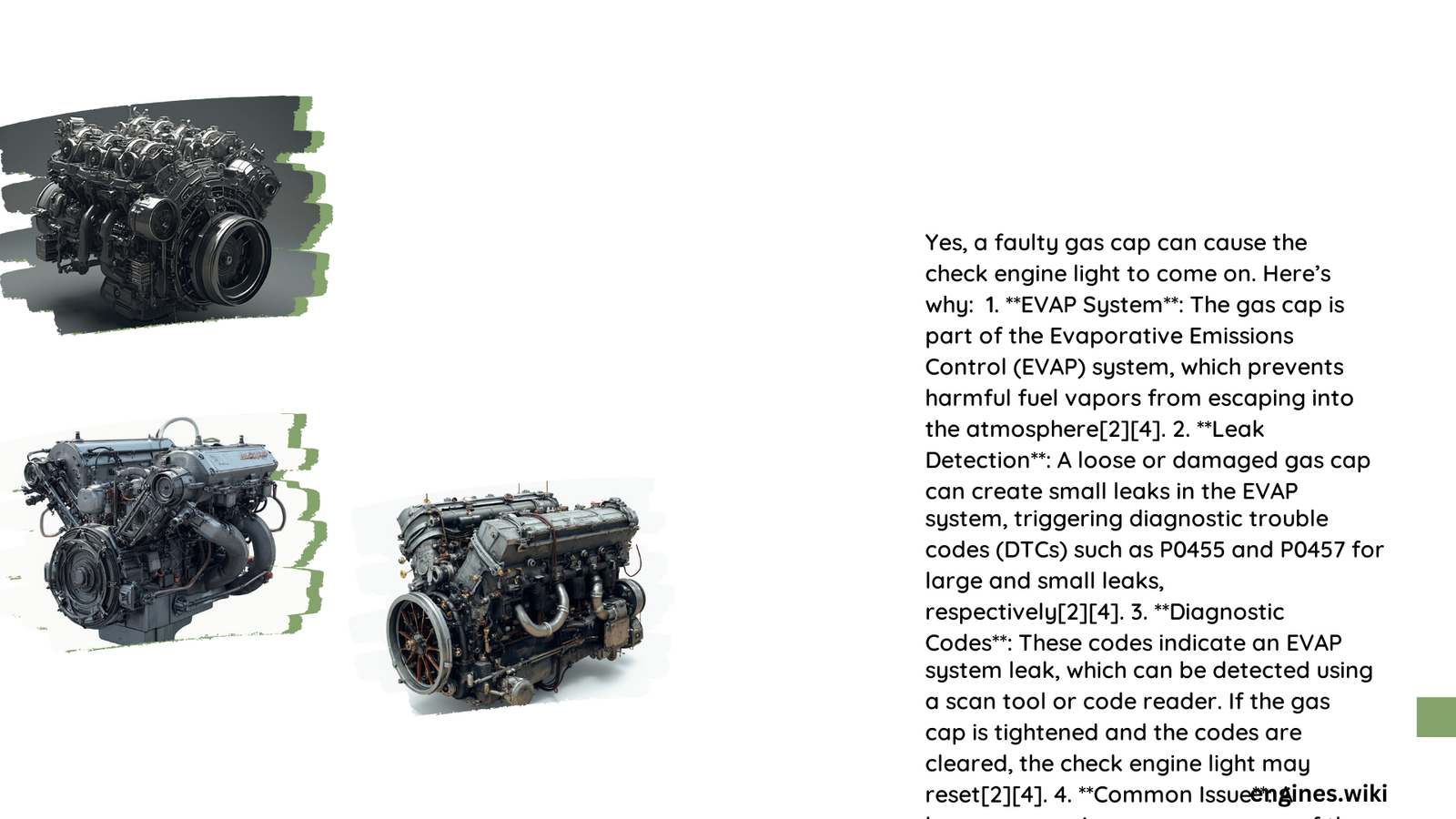A faulty gas cap can indeed trigger the check engine light in modern vehicles. This common issue occurs when the gas cap is loose, damaged, or has a weakened seal, allowing fuel vapors to escape. The vehicle’s onboard diagnostic system detects this vapor leak, often resulting in the illumination of the check engine light. Understanding this connection can save car owners time and money in unnecessary repairs.
What Are the Specific Symptoms of a Faulty Gas Cap?
When a gas cap is faulty, several symptoms may manifest:
- Illuminated check engine light
- Decreased fuel efficiency
- Smell of gasoline near the fuel tank
- Difficulty in tightening the gas cap
These symptoms occur because a compromised gas cap disrupts the vehicle’s evaporative emission control (EVAP) system, which is designed to prevent fuel vapors from escaping into the atmosphere.
How Does a Loose Gas Cap Affect Vehicle Performance?

A loose gas cap can have several measurable effects on your vehicle:
- Fuel Efficiency: You may notice a decrease in miles per gallon as fuel vapors escape.
- Emissions: Increased emissions due to escaping fuel vapors.
- Engine Performance: Slight changes in engine performance due to altered fuel-air mixture.
Table: Impact of Loose Gas Cap on Vehicle Performance
| Aspect | Effect |
|---|---|
| Fuel Efficiency | Decreased |
| Emissions | Increased |
| Engine Performance | Slightly affected |
What Diagnostic Trouble Codes Are Associated with a Faulty Gas Cap?
When the check engine light comes on due to a faulty gas cap, specific diagnostic trouble codes (DTCs) are often stored in the vehicle’s computer:
- P0455: Evaporative Emission System Leak Detected (large leak)
- P0457: Evaporative Emission System Leak Detected (fuel cap loose/off)
These codes indicate that the EVAP system has detected a leak, which is often caused by a loose or faulty gas cap.
How Quickly Does the Check Engine Light Respond to a Loose Gas Cap?
The check engine light’s response to a loose gas cap can vary:
- Immediate activation in some vehicles
- Delayed response after several drive cycles in others
Factors influencing the response time include:
- Vehicle make and model
- Sensitivity of the EVAP system
- Severity of the gas cap issue
What Is the Process for Diagnosing a Faulty Gas Cap?
To diagnose a faulty gas cap:
- Visually inspect the gas cap for damage
- Ensure the gas cap is tightened properly
- Use an OBD-II scanner to check for EVAP-related codes
- Perform a smoke test to detect any leaks in the EVAP system
If these steps confirm a faulty gas cap, replacement is typically the best solution.
How Much Does It Cost to Replace a Gas Cap?
Replacing a gas cap is generally an inexpensive fix:
- Cost range: $10 to $30
- Professional installation: Usually not necessary
Factors affecting cost:
- Vehicle make and model
- OEM vs. aftermarket parts
- Purchase location (dealership, auto parts store, online)
What Are the Environmental Implications of a Faulty Gas Cap?
A faulty gas cap can have significant environmental impacts:
- Increased fuel vapor emissions
- Higher overall vehicle emissions
- Contribution to ground-level ozone formation
These environmental effects underscore the importance of maintaining a properly functioning gas cap.
How Does Gas Cap Replacement Affect Check Engine Light Status?
After replacing a faulty gas cap:
- Tighten the new cap securely
- Clear the diagnostic trouble codes with an OBD-II scanner
- Drive the vehicle for several cycles
The check engine light should reset within a few days to a couple of weeks, depending on the vehicle and driving patterns.
Are There Different Types of Gas Caps for Various Engine Types?
While gas caps serve the same basic function across vehicles, there are variations:
- Standard screw-on caps
- Capless fuel systems in some modern vehicles
- Locking gas caps for added security
It’s crucial to use the correct type of gas cap for your specific vehicle to ensure proper sealing and EVAP system function.
What Are the Long-Term Effects of Driving with a Faulty Gas Cap?
Prolonged driving with a faulty gas cap can lead to:
- Decreased fuel efficiency over time
- Potential damage to the EVAP system
- Failed emissions tests
- Increased environmental impact
Addressing a faulty gas cap promptly can prevent these long-term issues and maintain optimal vehicle performance.
How Can Drivers Prevent Gas Cap-Related Check Engine Light Issues?
To prevent gas cap-related check engine light issues:
- Regularly inspect the gas cap for damage
- Ensure proper tightening after each refueling
- Replace the gas cap at recommended intervals or if damage is noticed
- Keep the fuel filler area clean to prevent debris from interfering with the seal
By following these preventive measures, drivers can minimize the likelihood of experiencing check engine light issues related to the gas cap.
References:
- https://ferberstireandauto.com/why-does-a-loose-gas-cap-trigger-a-check-engine-light/
- https://everythingeuro.com/tips/common-check-engine-light-cause/
- https://www.carparts.com/blog/can-a-loose-gas-cap-turn-on-the-check-engine-light/
